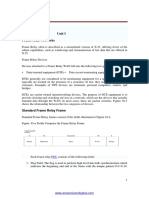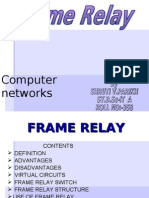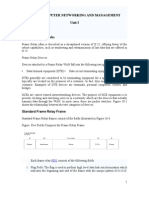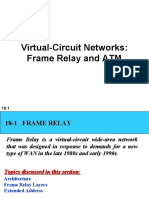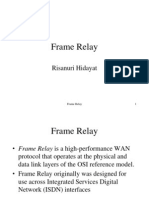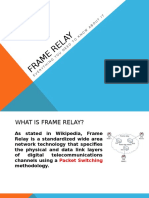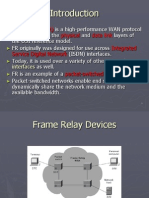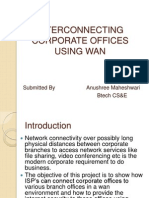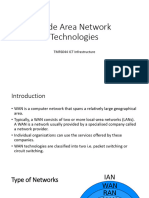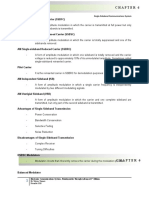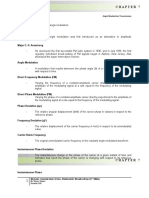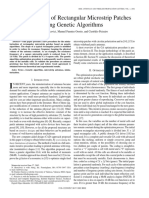FRAME RELAY ATM
Frame Relay
A wide area network technology that uses fast packet switching technique to meet the demands of high speed bursty traffic A technique used in data transport network where error checking is performed end-to-end instead of individual link
�Frame Relay
Frame Relay is a packet-switched, connection-oriented, WAN service. It operates at the data link layer of the OSI reference model. Frame Relay uses a subset of the high-level data link control (HDLC) protocol called Link Access Procedure for Frame Relay (LAPF). Frames carry data between user devices called data terminal equipment (DTE), and the data communications equipment (DCE) at the edge of the WAN.
�Frame Relay
Most Popular PSDN Today Offers speeds of 64 kbps to about 40 Mbps; This covers the range of greatest corporate demand Most demand is at the low end of the range Priced aggressively Both reasons are critical Low-Cost Service Packet-Switched Uses virtual circuits to cut costs Unreliable Relatively low speeds Dedicated Connections - Always ready to send and receive
�Frame Relay
A Frame Relay network may be privately owned, but it is more commonly provided as a service by a public carrier. It typically consists of many geographically scattered Frame Relay switches interconnected by trunk lines. Frame Relay is often used to interconnect LANs. When this is the case, a router on each LAN will be the DTE. A serial connection, such as a T1/E1 leased line, will connect the router to a Frame Relay switch of the carrier at the nearest point-of-presence for the carrier (access circuit)
�Frame Relay Operation
In frame relay, an intelligent endpoint, such as LAN, will send its data to the link layer. No more storing of data before sending to another node. When each node receives the beginning of a frame, it may immediately transmit that frame to the next node without waiting for the whole frame to be received and stored, therefore, a much faster transmission and switching. An envelope (LAPD Frame) is added. Alternatively, the intelligent endpoint may send the data to the network already encapsulated in the LAPD frame
�Frame Relay Operation
The LAPD frame contains routing information, eliminating the need for the network to examine. Instead, the frame itself is examined for a destination and the routing takes place at the networks frame layer. No error correction in the frame relay nodes because frame relay relies on low bit error rate lines to minimize errors, and on intelligent endpoints running an end-toend protocol across the network to recover from the few errors that do occur After reaching its destination node, the envelope is removed and the data is delivered to the endpoint
�Types of Congestion in Frame Relay
Receiver congestion Line congestion FECN Forward Explicit Congestion Notification BECN Backward Explicit Congestion Notification
�Error Control in Frame Relay
Cyclic Redundancy Check (CRC) error detection Automatic Repeat Request (ARQ) error correction Discard Eligibility (DE)
�Frame Relay Terms
Committed Information Rate (CIR) the average rate (in bps) at which the network guarantees to transfer information units over a measured intervall Committed Burst Size (Bc) the maximum number of information units that can be transmitted during the time interval Be the number of uncommitted information units that the network will attempt to carry during the time interval
�Frame Relay Access Equipment
Bridge Router Host Frame Relay Access Device
�Data Terminal Equipment (DTE)
DTEs generally are considered to be terminating equipment for a specific network and typically are located on the premises of the customer. The customer may also own this equipment. Examples of DTE devices are routers and Frame Relay Access Devices (FRADs). A FRAD is a specialized device designed to provide a connection between a LAN and a Frame Relay WAN.
�Data Communications Equipment (DCE)
DCEs are carrier-owned internetworking devices. The purpose of DCE equipment is to provide clocking and switching services in a network. In most cases, these are packet switches, which are the devices that actually transmit data through the WAN. The connection between the customer and the service provider is known as the User-to-Network Interface (UNI). The Network-to-Network Interface (NNI) is used to describe how Frame Relay networks from different providers connect to each other.
�Frame Relay Access Device (FRAD)
Access Device PSDN Device at each site to connect site network to Frame Relay WAN Paid to PSDN carrier or an equipment manufacturer
�Frame Relay terminology
The connection through the Frame Relay network between two DTEs is called a virtual circuit (VC). Switched Virtual Circuits (SVCs) are Virtual circuits may be established dynamically by sending signaling messages to the network. However, SVCs are not very common. Permanent Virtual Circuits (PVCs) are more common. PVC are VCs that have been preconfigured by the carrier are used. The switching information for a VC is stored in the memory of the switch.
�Permanent Virtual Circuits (PVC)
PVC Leased Access Line
PVC
Leased line meshes had a leased line to each site PSDNs, usually have PVCs wherever there were leased lines between sites in the previous leased line network Eases the transition to PSDNs from leased lines PVCs to other sites are multiplexed over a sites single leased access line Pay monthly charge per PVC, based on speed
�Frame Relay Frame Structure
�Frame Relay Frame Structure
�Frame Relay Frame Structure
�Frame Relay Frame Structure
�Frame Relay Frame Structure
Variable Length Frames
Start flag (01111110) to signal start of frame Address field has variable length (2-4 octets) Information field to carry data (variable) CRC (Cyclical Redundancy Check) field to detect errors (2 octets) ; If find errors, switch discards the frame Stop flag (01111110) to signal end of frame
�Frame Relay Frame Structure
Address Field of Frame Relay Frame Variable Length: 2-4 octets 4-Octet form shown Complex
0
Bits
DLCI (6 bits) DLCI DLCI DLCI FECN BECN C/R DE
7 AE AE AE AE
�Frame Relay Frame Structure
Address Extension Bit (AE) 0 unless last octet 1 if last octet
Bits DLCI (6 bits) DLCI DLCI DLCI FECN BECN C/R DE 7 0 0 0 1
�Frame Relay Frame Structure
Address Field of Frame Relay Frame Data Link Control Indicator (DLCI) Indicates virtual circuit for switching Does not use destination addresses
0 Bits DLCI (6 bits) DLCI (4 bits) FECN BECN C/R DE 7 AE AE AE AE
DLCI (7 bits) DLCI (7 bits)
�Frame Relay Frame Structure
DLCI If address field is 2 octets long, DLCI is 10 bits long If address field is 3 octets long, DLCI is 17 bits long If address field is 4 octets long, DLCI is 24 bits long
0 Bits DLCI (6 bits) DLCI (4 bits) FECN BECN C/R DE 7 AE AE AE AE
DLCI (7 bits) DLCI (7 bits)
�Frame Relay Frame Structure
Discard Eligible Bit If send faster than committed rate, DE bit is set to 1 indicating that it may be discarded first
Bits DLCI (6 bits) DLCI DLCI DLCI FECN BECN C/R DE
7 AE AE AE AE
�Frame Relay Frame Structure Frame Relay
Congestion Notification
Frame Structure
If a switch detects congestion, it sets the FECN or BECN bit.
Bits DLCI DLCI DLCI DLCI FECN BECN C/R DE
7 AE AE AE AE
�Frame Relay Frame Structure
Command/Response bit Command/Response bit useful in applications that have commands and responses Not widely used
0 Bits DLCI (6 bits) DLCI DLCI DLCI FECN BECN C/R DE 7 AE AE AE AE
��Asynchronous Transfer Mode (ATM)
A cell-based, connection oriented, switching and multiplexing technology that allows voice, video and data to be sent along the same network. A high speed, connection oriented switching and multiplexing technology that uses 53 byte cells (5 byte header, 48 byte payload) to transmit different types of traffic simultaneously. It is asynchronous in that information streams can be sent independently without a common clock Network equipment can switch, route and move uniform sized frames much more quickly that it can in random sized frames. Constant bit rate: voice and video Variable bit rate: data
�Asynchronous Transfer Mode (ATM)
Packet switched Virtual circuits Dedicated (Always On) Connections Much faster top speed (up to 2.4 Gbps) Maximum latency for time-critical applications Exact cell-by-cell timing Very Expensive Complexity because of basic transmission mechanisms Complexity because of quality of service mechanisms High-speed transmission
�ATM components
Routers and switches to connect carrier on a global basis Backbone devices to connect all LANs within a large organization Switches and adapters which link desktop computers to high speed ATM connection for running multimedia applications
�ATM media
Coaxial cables Twisted pair cables Fiber optic cables
�ATM layers
Physical Layer responsible for the electrical or optical transmission and reception along the physical media between two devices ATM Layer (Network Layer) deals with moving cells from source to destination and involves routing algorithms and protocols within the ATM switches ATM Adaptation Layer adapts user traffic to a cell format ATM Services and Application Layer
�ATM Interfaces
User to Network Interface (UNI) Network to Network Interface (NNI) Data Exchange Interface (DXI) Intercarrier Interface (ICI)
�ATM Applications
Home working (SOHO) Home shopping Video on demand (pay-per-view) Interactive multimedia games Distance Learning










